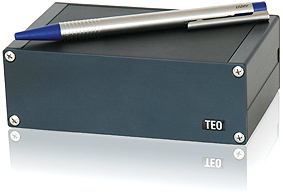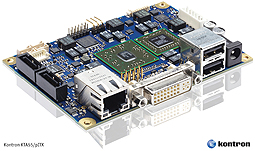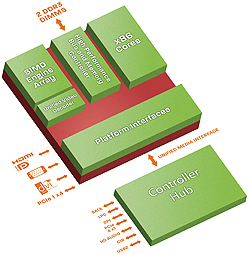Christmann has added a tiny but powerful mini server to its portfolio – the TEO-XXS. Developed by the Kontron Value Added Reseller (VAR) ies and based on a 2.5 inch Pico-ITX™ embedded motherboard with AMD Embedded G-Series platform, the mini server provides a boost to performance and graphics capability, particularly for space-saving, energy-efficient and robust embedded applications.
by Daniel Piper, Product Marketing Manager, Kontron AG
Continuous advancement in the semiconductor industry has enabled an increasing number of functions to be integrated into less space. CPUs have consequently become faster, increasingly

versatile and more energy efficient over time, allowing increasingly compact system designs to be designed. Despite enormous improvements in performance and power consumption, one aspect of embedded computing has always lagged behind, until now: the graphics performance integrated into the chipset. Because embedded computing technology has conquered new vertical markets such as multimedia content delivery, kiosks, POI/POS and gaming, the need for long-term available solutions is on the increase, and these must also satisfy the growing demand for graphic intensive applications in a highly integrated form. Above all, despite increased performance, systems must facilitate ever more compact installations.
Mini server with maximum performance
Christmann is now able to demonstrate this advancement in processor technology integration. The resource efficient IT solutions specialist has enhanced its portfolio with one of the tiniest mini IT systems in the world. The TEO products are based on the Thin Economic Office concept, in which computers are reduced to a bare minimum in order to minimize energy and maintenance costs.
The mini TEO system can also be deployed as an embedded server, because with a size of 129mm × 80mm × 44mm, it is hardly larger than a 500 gram packet of butter. The Accelerated Processing Unit (APU) combines a 1.0GHz dual-core CPU with a graphics unit of the same standard as dedicated graphics cards, all on a single chip. This provides an extremely advanced computing performance and graphics functionality, including the option to show two different contents, such as showing full HD on separate displays. This is particularly relevant to twin installations, in which the embedded server takes on the task performed by two OEM systems. Examples include digital signage with double sided independently controlled screens and kiosk terminals that are used as airport check-in systems. Another benefit of the TEO XXS G-Series mini server for deployment in the digital signage area, as well as for measurement and control applications, is its completely sealed and robust aluminum housing with protection category IP54, which prevents the ingress of dust, dirt and splash water. The mini server is thus also ideal for installation outside of protected areas.
Most significant features
The compact design came about by only implementing the most important standard features: 2× graphic connectors as well as 1x Ethernet and 2× USB 2.0 – which is sufficient connectivity in most cases. For applications requiring further connectivity, a choice of interfaces for the TEO XXS G-Series mini server can also be implemented. These include a second Ethernet port, WLAN or UMTS connectivity options, which makes the box ideal for numerous applications with remote access requirements. A 2.5 inch IDE hard drive with up to 320GB is included in the basic configuration. A fast and robust Solid State Drive (SSD) is available optionally, which enables operation in harsh environments that are prone to shock and vibration, such as machine rooms and vehicles. Silent operation is an attractive additional feature, because this is ideal for applications in which the noise of a hard drive would be disturbing, such as in the health sector in patient areas, as thin clients in each ward or doctor’s room or in professional digital signage applications or in A/V equipment for hotels or conference rooms.
Greater integration in less space
The most important factor influencing the compact system is the processor used and its level of integration with the chipset. This is not only because it determines the number of additional components required, but it also impacts the power consumption in Watts. If this is particularly high, high performance cooling is needed, for example using larger convector fins or active fans. If the application also requires high performance graphics, a dedicated graphics card is usually required, which likewise requires its own space within the system and sufficient cooling. Despite the TEO XXS G-Series mini servers’ performance, the power consumption never exceeds 10W, even at full usage, which is why the system is able to operate without active cooling or ventilation slots.
Performance boost for low power appliances
This high energy efficiency in a small size is a result of the perfect thermal design of the TEO XXS, which is based on the advanced processor technology of the AMD Embedded G-Series APU. This combines a low-power ×86 CPU with a powerful Radeon™ graphics unit delivering the

performance of a dedicated graphics card. In addition to supporting DirectX11, the integrated AMD Radeon™ HD6310 graphics unit also supports OpenGL 4.0. It therefore provides excellent playback performance of 2D- and 3D- content with high frame rates and resolutions of up to 2560 × 1600 pixels.
This enables designs that are cost-efficient and space-saving with high performance graphics, without the need to use a dedicated graphics card. Furthermore, because the integrated Universal Video Decoder 3.0 relieves the main processor from decoding video streams, the AMD Embedded G-Series APU based TEO-XXS is a new benchmark for systems with comparable power consumption. The mini server can decode 1080p videos in HDCP as well as in HD MPEG-2 and DivX (MPEG-4) format.
The APU is also OpenCL capable, so that parallel processes can be efficiently offloaded to the GPU, which can crucially increase the complete performance of the system.
The AMD Embedded G-Series platform includes a total of seven different APUs, starting with a 1.0GHz single-core APU with AMD Radeon HD6250 graphics unit and a maximum of 5.5W TDP up to a 1.65GHz dual-core APU T56N with AMD Radeon™ HD 6320 maximum 18W TDP. It is therefore positioned for particularly compact, fanless SFF applications such as infotainment and Kiosk systems as well as digital billboards. The Christmann box includes an AMD T40N 1.0GHz dual-core processor with Radeon™ HD6290 graphics unit.
Headless variant for deeply embedded systems
For deeply embedded systems requiring no graphics output and no direct user input, three further AMD Embedded G-Series APUs are available in an even more energy efficient headless variant without integrated graphics, which, depending on the configuration require only 5W of power. Regarding power consumption, this makes the AMD Embedded G-Series APUs a genuine alternative to other particularly energy-efficient processor architectures. Thanks to the proven ×86 technology, the advantage is being able to revert to a massive tried and tested software ecological system. Major software modifications and migrations are unnecessary. With such applications in mind, ies from Meinerzhagen Germany in collaboration with Kontron are able to implement other dedicated interfaces in place of the DVI graphics interface. This can take place via a custom design of the board or via small USB expansion cards, which are easily integrated into a slightly larger housing.
Embedded applications need more than just performance
The availability of advanced embedded processor technology is not enough. The entire system design must be provided reliably and with long-term availability. Kontron, a global leader in embedded computing technology, was one of the first manufacturers of embedded hardware to provide the AMD Embedded G-Series APU on an industrial grade Pico-ITX™ motherboard, which is why Christmann chose to implement the desired AMD design with Kontron and ies. Pico- ITX™ is the smallest industrial grade form factor and is therefore ideal for particularly compact and reliable system designs.

The Kontron embedded motherboard 2.5″ Pico-ITX™ KTA55/pITX can host up to 4GByte of RAM on a DDR3 SODIMM module, so that ies or Christmann can scale the system configuration to meet individual requirements.
The integrated Unified Video Decoder minimizes CPU usage during the decoding of H.264, VC-1, MPEG, WMV and DivX HD videos. Together with High Definition Audio (HDA) which provides crystal clear audio output, the 2.5″ Pico-ITX™ embedded motherboard facilitates extremely energy efficient video applications. Up to 6 × USB 2.0 (4× USB via pin headers) enable the board to realize a wide spectrum of application specific enhancements via cost-efficient peripheral components. The integrated 1000/100/10 Ethernet connection provides the highest bandwidth and compatibility for networked applications. Storage media is connected via two 6.0 Gbit/s SATA interfaces, which enable maximum utilization of transfer rates offered by even the latest solid state drives. Other features include a Trusted Platform Module for data security, an LPC bus and eight configurable GPIOs.
Expansion options inclusive
Christmann does not require all of these features for the mini design, because they want to achieve the maximum space saving for classical mini systems. However the board features enable application specific expandable system designs to be implemented at any time. Furthermore, the company ies is able to develop and/or implement further I/Os as required, which can optionally be connected via USB implemented expansion modules.
Wolfgang Christmann, General Manager of Christmann GmbH & Co. KG explained:
“We wanted to enhance our range of extremely compact mini-servers with a particularly powerful model that includes high performance graphics, in order to satisfy the ever increasing demand for graphics sophistication. The AMD Embedded G-Series is the ideal ×86 platform for this.
The ies system design is therefore a sophisticated one and the overall high quality of the solution will definitely impress more than only IT vendors and commercial end users of (thin-) client solutions. The team from ies and Kontron that we selected can definitely stem many more requirements, which lie outside our field of activity as a provider of classical IT hardware.
Our customers from areas such as hospitals and public authorities are also pleased if IT hardware is long-term available and can thus be supplied in identical configurations over the years, because this greatly simplifies the IT administrator service.”
www.kontron.com
Author

Daniel Piper
Product Marketing Manager
Kontron AG


